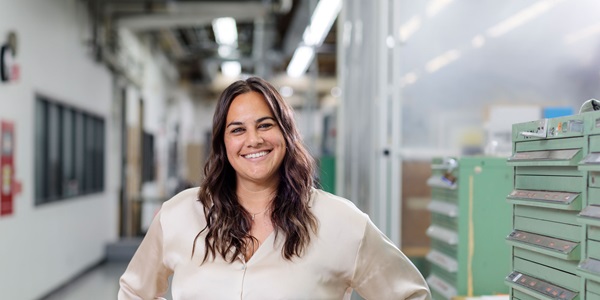Traci said Northrop Grumman's inclusive culture empowered her to share her authentic self.
Well Played
By Rhonda Hewitt

Whether exploring fantasy realms or creating the latest virtual reality scenarios at work, Software Developer Kayla Clay draws inspiration from the dynamic world of interactive video games — and she always has.
Growing up, she would tag along with her older brother when he visited friends and, to keep her occupied, they would let her play Pokémon® Stadium on the Nintendo 64® or the original Sims™ game, unknowingly sparking a lifelong fascination with the virtual worlds and adventures that gaming has to offer.
At first, she was fascinated just by hitting buttons and watching the changing display. This progressed to understanding not only how to play but how to complete new levels and, ultimately, beat the games, again and again.
“When I was seven, I began liking the replay ability of the games,” said Kayla, referencing how the games’ extra characters, secrets and alternate endings make them fun to play multiple times. “I found I was pretty good with solving problems and puzzles.”
A Budding Gamer
As she grew older, her gaming hobby evolved into a true passion, shaping not only what she did in her spare time, but also influencing her career choices. When she was ready to head to college, her mother suggested that she explore game design as a major.
“Classes involving game writing were my favorite,” she said. “It was a chance to develop character backgrounds and different storylines. Plus, as a writer, you’re involved in all aspects of a game from initial design to final production.”
In 2016, Kayla graduated with a bachelor’s degree in game design from George Mason University, where she studied everything from the artistic components, sound and animation to technical skills and programming.
From Gaming to Developing Simulated Combat Training
After graduation, her plan was to seek a position at a video game company. For a while, she worked for BreakAway Games in Hunt Valley, Maryland, making nursing simulations for nursing students. In 2020, Chrysantus Bandon-Bibum — Kayla’s friend and a Northrop Grumman systems engineer — suggested that Kayla explore opportunities at Northrop Grumman. Kayla applied and was hired as a software developer supporting the PC-based Open-Architecture for Reconfigurable Training Systems (PORTS) program in Middletown, Rhode Island.
“We build simulation-based training systems for the U.S. Navy, specifically for surface ships — destroyers, cruisers, aircraft carriers,” said Sue Panichas, Kayla’s manager and the PORTS project manager. “In a nutshell, we replicate the displays and controls of the tactical consoles and put enough math and science in the background so that the simulated consoles work the same as they do on the ship.”
This way, student sailors can learn how to do their jobs and practice multiple times to build proficiency. According to Sue, the training devices are hosted on PCs with up to five monitors and delivered to Navy classrooms and labs. There, the instructor can create and control a scenario — ships, planes and submarines, all moving around a geographic area — and influence the students by inserting challenging conditions for them to work through.
“These interfaces encompass everything from identifying another ship and communicating that with your fellow crew members to targeting a hostile ship, going through all the steps necessary to prepare for combat — loading weapons and getting authorization from superiors — and actually firing at an enemy ship,” said Kayla, who, in her role, creates 2D graphical interfaces. “For me, this is a perfect position because I can teach the sailors how to use their ships in a fun, exciting and interactive way.”
Life at Northrop Grumman
Your work at Northrop Grumman makes a difference. Whether you want to design next-generation aircraft, harness digital technologies or build spacecraft that will return humanity to the moon, you’ll contribute to technology that’s transforming the world. Check out our career opportunities to see how you can help define possible.


